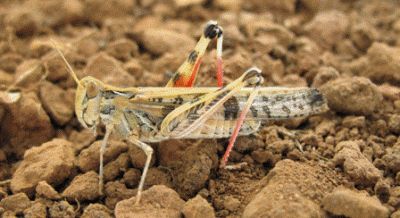AUSTRALIAN plague locust populations declined to low densities in most regions during autumn and there is only a slim chance of widespread regional infestations occurring during the forthcoming summer, according to the latest outlook from the Australian Plague Locust Commission (APLC).
Despite the eastern half of NSW and Queensland receiving moderate-heavy rainfall during March, which could have initiated some localised autumn egg laying, there was little winter rainfall and September remained dry in all regions, so habitat conditions are unsuitable for nymph survival in most areas.
In South Australia, surveys in late September identified only occasional adult locusts in the Far North region and around the Flinders Ranges.
Current locust distributions are at low background population densities with dry habitat conditions limiting the survival of spring generation nymphs.
Low soil moisture may also have left some eggs in quiescence, which could hatch after moderate rainfall.
The outlook for the remainder of spring is for population densities to remain low in all regions of inland eastern Australia.
Spring hatchings have been reported in parts of the Western Australian wheatbelt, including Katanning and Wongan-Ballidu Shires.
The probability of population increases during November and summer is dependent on the distribution of moderate–heavy rainfall during the next three months.
Given the current very low population densities, the rapid development of widespread regional infestations is unlikely during summer.
However, seasonal rainfall forecast models suggest an average rainfall expectation over coming months and even isolated heavy rainfall events can result in localised large population increases.
Spur-throated locusts
With spur-throated locusts there is currently a low risk of swarms developing or migrating into agricultural regions during the remainder of spring and summer.
The outlook is for the maintenance of moderate population levels during 2017–18.
Migratory locusts
With migratory locusts, a survey of the Queensland Central Highlands and the northern South Central region during September identified low density adults at several locations south of Emerald.
Isolated density adults were recorded in the Rolleston and Taroom–Roma areas but no nymphs were detected.
There is a low probability of a widespread infestation developing in the Central Highlands, eastern Central West or South Central regions of Queensland during spring or summer.
Source: APLC
…………………………..
The APLC warns that it is important that any locust activity be reported as soon as possible to your local biosecurity authority, primary industries department or to the commission. A toll-free call to the APLC can be made on 1800 635 962. An answering machine is attached to this phone for after-hours calls.
Reports can also be emailed to APLC at [email protected] or made through the website at http://www.agriculture.gov.au/aplc


HAVE YOUR SAY